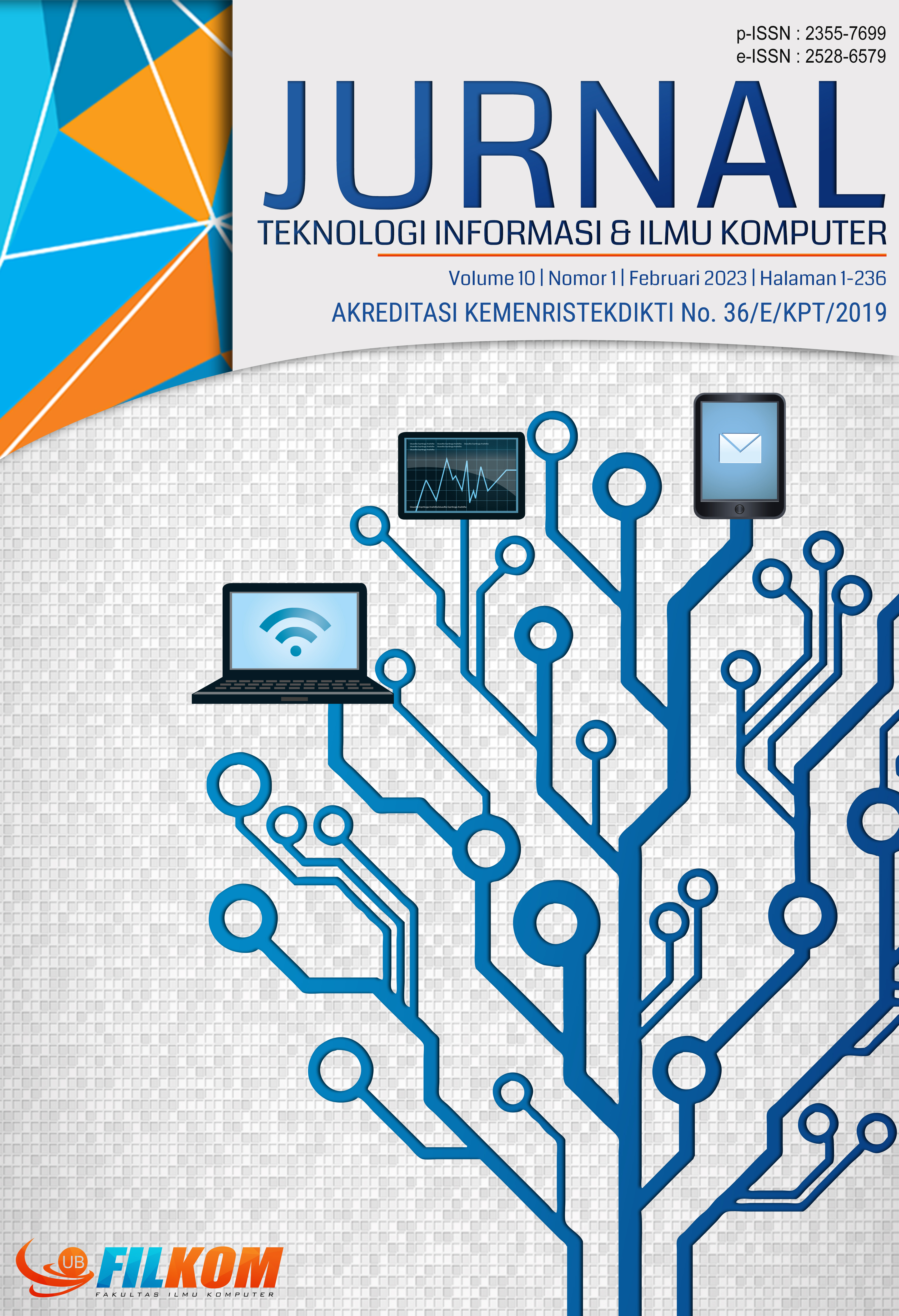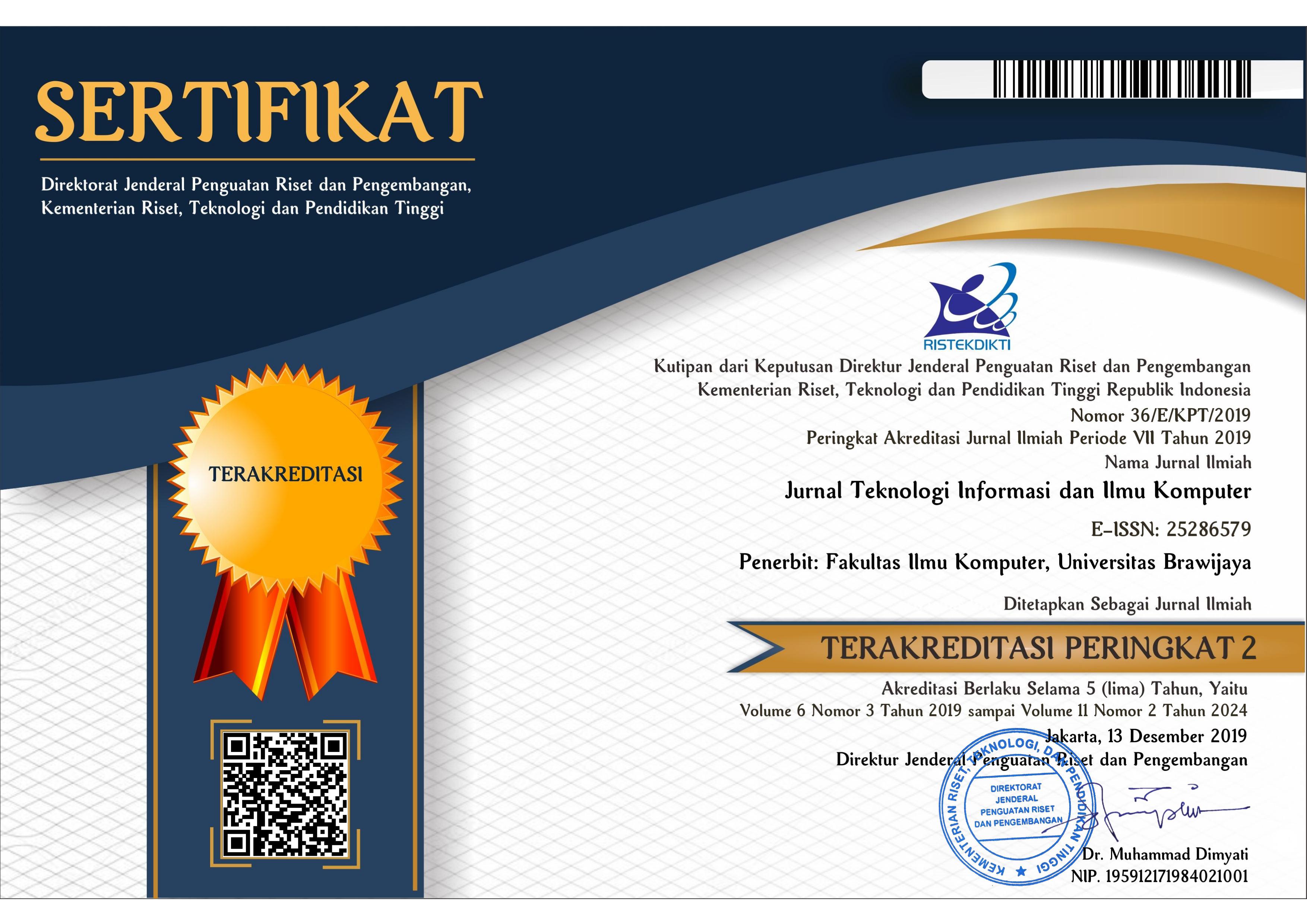Analisis Sentimen Kebijakan New Normal dengan Menggunakan Automated Lexicon Senti N-Gram
DOI:
https://doi.org/10.25126/jtiik.2023105006Abstrak
Dalam menghadapi pandemi COVID-19 ini, pemerintah Indonesia mengeluarkan beberapa kebijakan di antaranya adalah Pembatasan Sosial Berskala Besar, dan New normal. Kebijakan New normal ini kemudian menjadi ramai diperbincangkan oleh masyarakat. Analisis sentimen dari opini yang beredar terkait isu tersebut dapat dilakukan sehingga pemerintah dapat mengevaluasi kebijakan tersebut. Dalam penelitian ini diusulkan menggunakan Lexicon Senti-N-Gram untuk analisis sentimen dengan tujuan untuk mengetahui pengaruh Lexicon Senti-N-Gram pada analisis sentimen Bahasa Indonesia. Adapun penelitian ini menggunakan data sebanyak 350 data tweet yang terbagi menjadi 229 tweet kelas positif dan 121 tweet kelas negatif. Hasil evaluasi yang diperoleh dengan menggunakan data dengan stemming lebih tinggi dibandingkan dengan data tanpa stemming. Hasil pengujian kinerja sistem terhadap lexicon Senti-N-Gram mendapatkan nilai accuracy sebesar 63,42%, precision sebesar 77%, recall sebesar 62,88%, dan f-measure sebesar 69,23% dengan nilai rata-rata kappa antar Annotator sebesar 0.5395 untuk data yang melalui proses stemming. Berdasarkan hasil pengujian yang telah diperoleh dapat disimpulkan bahwa proses stemming serta proses translasi kata satu per satu yang dilakukan dapat memengaruhi kata berdasarkan konteksnya.
Abstract
In dealing with the COVID-19 pandemic, the Indonesian government has issued several policies, including Large-Scale Social Restrictions and New normal. The New normal policy then became widely discussed by the public. Sentiment analysis of the opinions circulating on this issue can be carried out so that the government can evaluate the policy. In this study, it is proposed to use the Lexicon Senti-N-Gram for sentiment analysis in order to determine the effect of the Lexicon Senti-N-Gram on Indonesian sentiment analysis. The research used 350 tweets, which were divided into 229 positive class tweets and 121 negative class tweets. The evaluation results obtained using stemming data were higher than those without stemming. The results of the system performance test of the Lexicon Senti-N-Gram obtained an accuracy value of 63.42%, 77% precision, 62.88% recall, and 69.23% f-measure with an average kappa value between Annotators of 0.5395 for data that goes through the stemming process. Based on the test results that have been obtained, it can be concluded that the stemming process and the process of translating words one by one can affect words based on their context.
Downloads
Referensi
AGARWAL, S. 2014. Data mining: Data mining concepts and techniques. In Proceedings - 2013 International Conference on Machine Intelligence Research and Advancement, ICMIRA 2013. https://doi.org/10.1109/ICMIRA.2013.45
ANWAR, F. 2020. Update Corona Indonesia 15 Agustus: Tambah 2.345, Total 137.468 Kasus. Health.Detik.Com.
DEY, A., JENAMANI, M., & THAKKAR, J. J. 2018. Senti-N-Gram: An n-gram lexicon for sentiment analysis. Expert Systems with Applications, 103, 92–105. https://doi.org/10.1016/j.eswa.2018.03.004
FITRI NIASITA, A., ADIKARA, P. P., & ADINUGROHO, S. 2019. Analisis Sentimen Pembangunan Infrastruktur di Indonesia dengan Automated Lexicon Word2Vec dan Naive-Bayes. J-Ptiik, 3(3), 2673–2679. http://j-ptiik.ub.ac.id
HUTTO, C.J. and GILBERT, E. 2014. VADER: A Parsimonious Rule-based Model for. Eighth International AAAI Conference on Weblogs and Social Media, 18. https://www.aaai.org/ocs/index.php/ICWSM/ICWSM14/paper/viewPaper/8109
INDRIATI, I., & RIDOK, A. 2016. Sentiment Analysis for Review Mobile Applications Using Neighbor Method Weighted K-Nearest Neighbor (Nwknn). Journal of Enviromental Engineering and Sustainable Technology, 3(1), 23–32. https://doi.org/10.21776/ub.jeest.2016.003.01.4
JACKOWAY, A., SAMET, H., & SANKARANARAYANAN, J. 2011. Identification of live news events using Twitter. 3rd ACM
SIGSPATIAL International Workshop on Location-Based Social
Networks, LBSN 2011 - Held in Conjunction with the 19th ACM
SIGSPATIAL GIS 2011. https://doi.org/10.1145/2063212.2063224
KIRITCHENKO, S., & MOHAMMAD, S. M. 2016. Happy Accident: A sentiment composition lexicon for opposing polarity phrases. Proceedings of the 10th International Conference on Language Resources and Evaluation, LREC 2016, 1157–1164.
LIN, Y., WANG, X., & ZHOU, A. 2016. Opinion spam detection. In Opinion Analysis for Online Reviews (Issue May). https://doi.org/10.1142/9789813100459_0007
ORGANIZATION, W. H. 2020. Pertanyaan dan jawaban terkait Coronavirus. Www.Who.Int. https://www.who.int/indonesia/news/novel-coronavirus/qa/qa-for-public
PUTSANRA, D. V. 2020. Arti New Normal Indonesia: Tatanan Baru Beradaptasi dengan COVID-19. Www.Tirto.Id. https://tirto.id/arti-new-normal-indonesia-tatanan-baru-beradaptasi-dengan-covid-19-fDB3
ROFIQOH, U., PERDANA, R. S., & FAUZI, M. A. 2017. Analisis Sentimen Tingkat Kepuasan Pengguna Penyedia Layanan Telekomunikasi Seluler Indonesia Pada Twitter Dengan Metode Support Vector Machine dan Lexion Based Feature. Jurnal Pengembangan Teknologi Informasi Dan Ilmu Komputer (J-PTIIK) Universitas Brawijaya, 1(12), 1725–1732. http://j-ptiik.ub.ac.id/index.php/j-ptiik/article/view/628
Unduhan
Diterbitkan
Terbitan
Bagian
Lisensi

Artikel ini berlisensi Creative Common Attribution-ShareAlike 4.0 International (CC BY-SA 4.0)
Penulis yang menerbitkan di jurnal ini menyetujui ketentuan berikut:
- Penulis menyimpan hak cipta dan memberikan jurnal hak penerbitan pertama naskah secara simultan dengan lisensi di bawah Creative Common Attribution-ShareAlike 4.0 International (CC BY-SA 4.0) yang mengizinkan orang lain untuk berbagi pekerjaan dengan sebuah pernyataan kepenulisan pekerjaan dan penerbitan awal di jurnal ini.
- Penulis bisa memasukkan ke dalam penyusunan kontraktual tambahan terpisah untuk distribusi non ekslusif versi kaya terbitan jurnal (contoh: mempostingnya ke repositori institusional atau menerbitkannya dalam sebuah buku), dengan pengakuan penerbitan awalnya di jurnal ini.
- Penulis diizinkan dan didorong untuk mem-posting karya mereka online (contoh: di repositori institusional atau di website mereka) sebelum dan selama proses penyerahan, karena dapat mengarahkan ke pertukaran produktif, seperti halnya sitiran yang lebih awal dan lebih hebat dari karya yang diterbitkan. (Lihat Efek Akses Terbuka).














